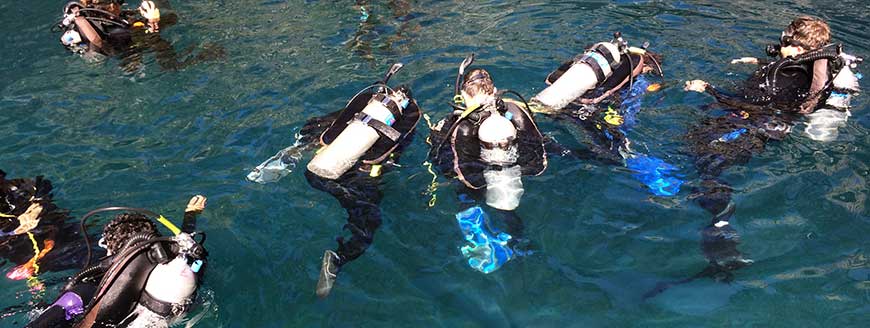 People often ask me where I get my material. It’s really very simple. I just go to a local open water dive site (any site will do) and wait ten minutes. What I will see during those ten minutes will be more than enough for a lengthy article. Today was no exception.
People often ask me where I get my material. It’s really very simple. I just go to a local open water dive site (any site will do) and wait ten minutes. What I will see during those ten minutes will be more than enough for a lengthy article. Today was no exception.
I had to go by Blue Grotto to speak to Kurt about a video shoot coming up at the end of the week. While there, I decided to go to the water to visit my favorite reptile. During those ten minutes, I saw a number of things. Some good. Some bad. Some downright ugly.
First, the good
When I arrived at the water, there was a large beginning class doing skills at the surface. Although the group was large, it was readily apparent they were well-prepared and well organized. I wish I had been able to learn the instructor’s name, because I would then be able to give him some well-deserved recognition.
Had I arrived at the water just a few seconds sooner, I would have seen what was about to happen and been able to capture it on video with my phone. As it turned out, all I was able to do was snap a few still photos after-the-fact.
What I saw was the instructor having all of his students, as a group, remove their fins while floating on the surface. After having everyone hold their fins up out of the water, the students then put their fins back on while still floating on the surface.

Why was this significant? There are a number of situations in diving in which the speed with which divers can enter and exit the water can greatly increase if the divers are able to don or remove their fins will floating on the surface. Blue Grotto is just one such example.
When I was getting sea time for my captain’s license on the old Pro Diver, we frequently had passengers remove their fins while hanging onto the tagline. This way, they were ready to exit as soon as they hit the boarding ladder and did not force other divers to wait while they struggled to get fins off.
To the best of my knowledge, this skill does not appear on any training organization’s cue cards. It should. In fact, there needs to be a greater emphasis in entry-level diver training on the correct way to don and remove fins. I frequently see divers struggle with things such as the Figure 4 position or the best way to manage quick-release heel straps.
Take a look at this one minute video, produced by two of my protégés, Rick Carlson and Aaron Lazar (with a little help and direction from The Old Guy). Do you cover all these points in your entry-level scuba course? Do your students leave class comfortable and confident in these abilities?
The instructor I saw clearly gets it. So do his students. This is something we need to see more of.
Now the bad…
While I was watching the scuba class complete their fin removal/replacement exercise, two teenage boys shuffled down from the upper deck while wearing fins. Clearly no one had taught them that you do not walk with fins on unless specifically told to do so by someone like the crew of a dive boat.
The boys were soon joined by their mother, who entered the water with them and proceeded to swim away from the dock. When clear, all three vented their BCs and attempted to descend. Despite appearing to be properly weighted, one of the boys was having difficulty getting down.
I got the mom’s attention and explained that the problem was that her son still had air trapped in his BC air cell. Because his large-diameter inflation/deflation hose was restrained by a shoulder epaulet, he could not hold the hose high enough to vent the upper portion of the air cell. I suggested he try pulling down on the hose to activate the quick dump located at the hose elbow. This is when the real trouble began.
I’m not sure about the exact vintage of these particular BCs, but they clearly dated from a time when Zeagle was equipping their units with what Jared (JJ) Jablonski once described as “elephantine” inflator hoses.

Seriously, these inflator hoses had to be at least two feet long. This meant that, try as he might, the young man could not pull down far enough on the inflator hose to activate the quick dump. This further increased his frustration and he ended up electing not to dive. It’s a problem that could have been avoided had his parents simply had their local dive store upgrade the BC with the shorter inflation hose found on newer Zeagle BCs.
Another factor in the equation was that the young man could not seem to grasp how to orient his body so that the quick dump was at the highest point. This is something a lot of new divers have a problem with. You see, adding air to a BC is easy; you just push a button. You can do it while horizontal, vertical or standing on your head. The challenge is learning how to orient your body so that you can quickly and completely vent the BC air cell.

When teaching new divers, it is important to have them hold their partially inflated BC out in front of them, to visualize how they would need to position their bodies in order to vent air while both horizontal and vertical. Doing so will help make the process of learning to control buoyancy vastly easier.
…and now the truly ugly
If you have seen Blue Grotto’s safety and orientation video, you know that there is an entire section devoted to Consideration for Others. A point emphasized here is the importance of not blocking the stairs while putting on fins. Every diver who enters Blue Grotto has to initial a box on the waiver form that indicates they have watched this video and agreed to abide by the rules outlined. It’s clear, however, that not everybody pays attention.

While our fin-wearing teenagers were attempting to enter the water, they had to squeeze past another diver who had plopped her butt down on the stairs and was proceeding to take several minutes to struggle into her fins. This showed not only an inability to pay attention and follow directions, but an utter disregard for others as well.
When she had finally gotten her fins on, the young lady swam out from the dock, vented her BC and began sinking like a rock before her BC was fully emptied. This could only mean that she was egregiously overweighted — a condition that is not only dangerous but makes it even harder to control buoyancy under water.

You could watch what happened next from the surface. Unable to control her rate of descent, the diver elected to “hit the brakes” before slamming into the bottom. In other words, she started kicking like mad to slow down. All she succeeded in doing, however, was kicking up a huge cloud of silt. This not only ruined the visibility for her, but for everyone else as well.
What it all comes down to
Bear in mind, everything I have described here took place in a span of less than ten minutes. You will notice two recurring themes:
- The first of these is consideration. By making sure his students were proficient in fin removal and replacement, the instructor was not only showing but teaching consideration for others. By blocking the stairs, diving overweighted and ruining the visibility for others, the female diver showed she was thinking about no one other than herself.
- The second theme is the importance of teaching beyond the 20 or so skills that appear on your training agency’s cue cards. No training organization made the instructor teach the fin removal and replacement exercise, yet the instructor recognized how important this is. Better training could have helped the young man make an enjoyable dive rather than having to quit in frustration. Better training might also have helped shape the young woman’s attitude so that she thought of other divers instead of just herself.
Teaching people to dive is a huge responsibility. If you are not willing to go “all in,” you might want to consider teaching something else — like ping pong. Believe me, the rest of us will thank you for doing so.
